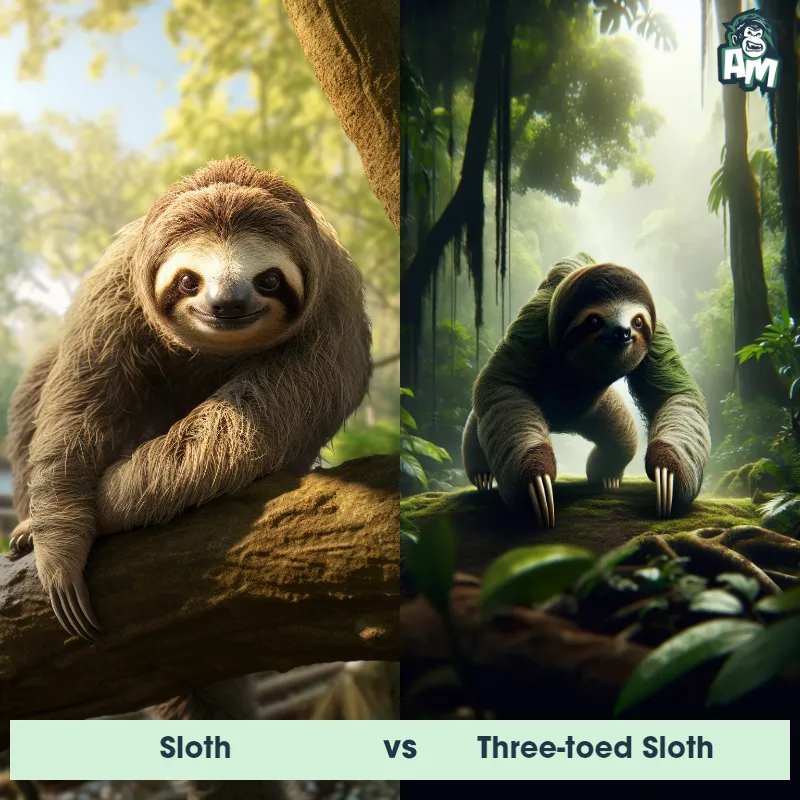The Three-Toed Sloth
The Three-Toed Sloth, also known as the Brown-Throated Sloth, is a slow-moving and arboreal mammal native to the tropical rainforests of Central and South America. It is named after its characteristic three-toed feet, which are adapted for hanging and climbing in trees. The sloth has a unique appearance with a short and stocky body, long and coarse fur, a small head, and a rounded snout. It has long limbs with curved claws that allow it to easily grasp tree branches. These creatures have a slow metabolism and spend most of their lives hanging upside down from branches, moving leisurely and blending in with the surrounding vegetation.

| Three-Toed Sloth | |
|---|---|
| Size | 2-2.5 feet (0.6-0.75 meters) |
| Weight | 8-17 pounds (4-8 kilograms) |
| Speed | 0.15mph (0.24km/h) |
| Key Strength | None |
| Biggest Weakness | Slow movements |
| Scientific Name | Bradypus |
| Family | Bradypodidae |
| Habitat | Forests |
| Geography | Central and South America |
| Diet | Herbivorous, mainly eats leaves |
| Lifespan | 10 years - 15 years |

The Three-Toed Sloth
The Three-Toed Sloth, also known as the Brown-Throated Sloth, is a slow-moving and arboreal mammal native to the tropical rainforests of Central and South America. It is named after its characteristic three-toed feet, which are adapted for hanging and climbing in trees. The sloth has a unique appearance with a short and stocky body, long and coarse fur, a small head, and a rounded snout. It has long limbs with curved claws that allow it to easily grasp tree branches. These creatures have a slow metabolism and spend most of their lives hanging upside down from branches, moving leisurely and blending in with the surrounding vegetation.
Fun Fact: Three-Toed Sloths have a specialized stomach that contains symbiotic bacteria, which helps them digest the tough and fibrous leaves that make up their primary diet.
| Three-Toed Sloth | |
|---|---|
| Size | 2-2.5 feet (0.6-0.75 meters) |
| Weight | 8-17 pounds (4-8 kilograms) |
| Speed | 0.15mph (0.24km/h) |
| Key Strength | None |
| Biggest Weakness | Slow movements |
| Scientific Name | Bradypus |
| Family | Bradypodidae |
| Habitat | Forests |
| Geography | Central and South America |
| Diet | Herbivorous, mainly eats leaves |
| Lifespan | 10 years - 15 years |
Three-Toed Sloth Matchups
We use AI to simulate matchups between the Three-Toed Sloth and other animals. Our simulation considers size, strength, and natural predatory behaviors to determine the most likely outcome.

Can't find the Matchup you want?
Create Your Own MatchupThree-Toed Sloth: Diet, Predators, Aggression, and Defensive Behaviors
What do Three-Toed Sloths eat?
Three-Toed Sloths primarily feed on leaves, shoots, and fruits. While they have a very low metabolism and digest food slowly, their diet provides them with the necessary nutrients and energy. They have been known to occasionally supplement their diet with insects, small reptiles, and birds.
Do Three-Toed Sloths have any predators?
Despite their slow movements, Three-Toed Sloths do have predators in the wild. Harpy Eagles and jaguars are known to prey on sloths, particularly when they are on the ground for bathroom breaks. Additionally, large snakes like anacondas also pose a threat to these peaceful creatures.
Are Three-Toed Sloths aggressive?
Three-Toed Sloths are generally docile and non-aggressive animals. They have a calm demeanor and prefer to avoid conflict whenever possible. They spend most of their time hanging upside-down in trees, conserving energy.
Do Three-Toed Sloths fight?
While Three-Toed Sloths are not known for being fighters, they may engage in minor disputes such as vocalizing or swatting at each other with their claws. These fights are more about asserting dominance or defending territory rather than causing harm.
How do Three-Toed Sloths defend themselves?
Three-Toed Sloths have developed several defense mechanisms to protect themselves from predators. Their main tactic involves blending into their surroundings with their slow movements and greenish fur, making them difficult to spot. Additionally, they can emit a loud scream if threatened, which can startle potential predators.
What is Three-Toed Sloths' biggest weakness in a fight?
One of Three-Toed Sloths' biggest weaknesses in a fight is their slow movement. Due to their leisurely pace, they are not well-equipped for quick escapes or agile maneuvers in a conflict. This lack of speed can make them vulnerable to attacks from faster predators.
Fun Fact: The Three-Toed Sloth is known for its incredibly slow movement, only covering a distance of about 38-55 feet per day, making it one of the slowest creatures on Earth.
Fun Fact: Unlike most mammals, the Three-Toed Sloth predominantly sleeps while hanging upside down from tree branches, and its long claws allow it to maintain its grip even when it's completely asleep.











